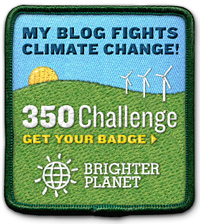New posts have been sadly lacking here lately, haven't they? I wanted to let you know that I'll be continuing to travel to Vancouver, BC for work for at least the next month, and I just don't think I'll be able to find the time to post much. So thanks for visiting, and feel free to check back in late November.
Lori
October 31, 2008
Hiatus
October 8, 2008
I love my local brewery!
My friend Stef pointed out this week that my favorite St Louis brewery (no, not THAT one) has crafted four distinctive beers in honor of the election season. Check out the labels for Schlafly's Baracktoberfest Beer, McCain's Maverick APA, Palin Ale and Hefebiden - they're hilarious. My favorite label is the Palin Ale - love that quote from the infamous Couric interview.
The question Stef posed in her Slashfood post today was quite intriguing - do people buy the beer that tastes better, or do they support their favored candidate? You make the call...
Anyone thirsty?
September 24, 2008
Laundry on the Brain
In case you're not familiar with Going Green, it's 'Burban Mom's blog about taking baby steps toward a more sustainable lifestyle. It's also one of my daily read blogs. Well, over the past few weeks, 'Burban Mom has been giving us suggestions for how to reduce our water use. For instance, today's outlined how to repair a leaky faucet. I'd highly recommend checking it out if you have a minute or ten.
Anyway, in the spirit of Going Green, I've been thinking about our household water consumption lately. You see, our old washer has been on the fritz off and on for years, and the dryer just decided to conk out. After eight years of service, the set has now officially been retired. Last month we received our brand new Samsung laundry set, and I’ve been having fun figuring out how to use the appliances to their best advantage. Since I apparently have laundry on the brain, I thought I’d share a few statistics and tips for how to green your laundry. After all, a few changes to the way you do laundry can help you save money, be healthier, and save our natural resources at the same time. What could be better?
According to Project Laundry List, about 35 billion loads of laundry are washed each year in the U.S. The average household washes about 50 pounds of laundry in 7.4 weekly loads, cleaning some 6,000 items annually. About half of all loads are done in warm water, 35% in cold, and 15% in hot. Some 90% of those loads are dried in a gas or electric dryer. That much laundry can have huge consequences for our environment. Here are a few suggestions for how to lessen the load on our planet.
- Don’t wash every item just because you’ve worn or used it once. Towels can go at least one week between washes, and some people have been known to wait much longer. For men who wear undershirts, your outer shirt, sweater or vest is probably not dirty after just one wearing. Khakis and other casual pants can also generally be worn more than once – if they’re a little wrinkly, you can spray with a little water and pop them into the dryer for a few minuets and they’ll freshen right up. Socks, underwear, undershirts are always washed after one wearing in our house. As far as I'm concerned, everything else is subject to a visual test (does it have spots, is it ridiculously wrinkly), and occasionally a smell test. Items that pass both of these tests generally go back in the appropriate closet or drawer to be worn again.
- Whenever possible, wash in cold water. We wash our towels, linens, socks, underwear and dog blankets in hot with a cold rinse. Everything else gets washed in cold. According to Seventh Generation, washing in cold can save 85% of the money and energy consumed by a hot water load. Not bad.
- Only wash when you have a full load ready. Some newer machines use a weight sensor to determine how much water to use, but the amount of energy expended does not drop proportionally. Washing only full loads will allow you to maximize the efficiency of the water, energy and detergent you’re using to get things clean.
- Use laundry detergents made from natural, biodegradable ingredients. Natural laundry products use eco-system-safe ingredients such as vegetable oils to clean your clothes. Conventional detergents often contain polluting compounds like alkylphenol ethoxylates (APEs), which can seriously harm the planet. Among other things, these nasty chemicals have recently been linked to the devastation of lobster populations off the eastern seaboard. We use Seventh Generation products, but there are several other good brands on the market these days if you look around a bit. Whole Foods or your local co-op store may carry multiple options so you can shop around for the product that fits you best. As I noted in this post, you can use vinegar instead of chemical-filled fabric softeners.
- Never use chlorine bleach. Chlorine bleach can combine with organic matter in your wash water to form toxic by-products. Hydrogen-based bleaches work just as well, are gentler on your clothes (extending their life means less resources spent on new clothes), and are much better for the environment.
- Air dry as much of your laundry as you can. Clothes dryers use quite a bit of energy to dry your clothes, and most cost over $75 a year to operate. Air drying uses zero energy and is completely free! If your neighborhood association won’t let you set up a line outside, or if you’re worried about pollen or critters, a rack or retractable lines in your basement or available space somewhere else in the house can be a great solution. I tend to air dry everything except towels, socks and underwear. All other items are either hung on hangers or set out on a rack in our basement. I do tend to run super-wrinkly pants and shirts in the dryer on its “air dry” setting for about 10 minutes when it seems necessary.
Hopefully this will help you maximize the efficiency of your existing washer and/or dryer. If you are looking to replace your current washer and/or dryer, there are a few things to consider.
- Consider a front-loading washer. Front loaders are gentler on clothes, use up to 36% less water, and suck down 60% less energy than top loaders. They will have a longer wash cycle that you’re used to, but drying times are greatly reduced due to a higher speed spin cycle. They’re more expensive, but they will recoup some of that cash outlay by reducing your all the rest of your laundry costs. You can also check with your local power and water companies for rebates on water-saving washers. We didn’t have these bonuses available in our area, but I know my parents received a significant rebate when they bought their front-loader.
- Look for the Energy Star label. If you run the numbers and don’t think the initial expense of a front-loader is ultimately affordable for you and your family, then Energy Star is the place to be. This Department of Energy designation is given to machines that use less energy and/or water than the industry average, meaning that appliances with this label will likely save you on detergent and your power and water bills throughout the life of the products.
Okay, that’s it for now. How about you? Do you have a tip to share about your laundry habits? I’d love to hear them, as I’m always trying to improve…










